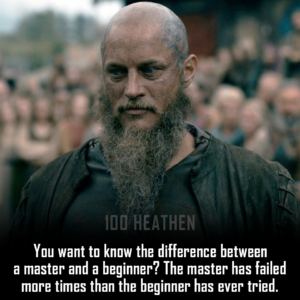
When we acquire a new skill, we go through the four stages of competence. These four stages are:
- Unconscious incompetence. The individual does not understand or know how to do something and does not necessarily recognize the deficit. They may deny the usefulness of the skill. The individual must recognize their own incompetence, and the value of the new skill, before moving on to the next stage. The length of time an individual spends in this stage depends on the strength of the stimulus to learn.
- Conscious incompetence. Though the individual does not understand or know how to do something, they recognize the deficit, as well as the value of a new skill in addressing the deficit. The making of mistakes can be integral to the learning process at this stage.
- Conscious competence. The individual understands or knows how to do something. It may be broken down into steps, and there is heavy conscious involvement in executing the new skill. However, demonstrating the skill or knowledge requires concentration, and if it is broken, they lapse into incompetence.
- Unconscious competence. The individual has had so much practice with a skill that it has become “second nature” and can be performed easily. As a result, the skill can be performed while executing another task. The individual may be able to teach it to others, depending on how and when it was learned. source: Wikipedia
Applying this model to Tai Chi learning, the first stage is when you decide to come, perhaps after seeing some Tai Chi demo or a movie where a hero is practising Tai Chi and you are unaware of what it means to learn Tai Chi.
Very quickly you move to a very frustrating stage two: conscious incompetence. Here, you struggle not knowing what to do with your limbs and how to memorise the movements.
Gradually, you move to conscious competence with knowing how to do bits and pieces of the Tai Chi form or separate techniques.
And if you persevere long enough, the movement becomes so engraved in your body that you can arrive at the unconscious competence stage.
What is interesting in going through the process (of acquiring a new skill), are the changes in how the consciousness is loaded. In the first stage, the consciousness is occupied by (perhaps) some fantasies, possibly mixed with worries (about one’s own abilities). So, essentially the consciousness is free.
At stage two, the consciousness is overloaded (often with panic and frustration), and that hinders the process of learning. When you focus on one thing, you forget another. There are not enough neurological connections in your body yet to enable the execution of movements etc.
Moving from stage two (overload) into stage three is accompanied by consciousness fully loaded. Now – to be able to do the Tai Chi form and to remember all its details, we are fully absorbed in action. If, at that stage, we lose focus, we forget what to do, or we start making mistakes.
Finally, when we arrive at stage four of the unconscious competence, (we created enough of necessary neurological connections), so our consciousness is freed enough.
Here we can focus on something else. For example, we may choose to pay attention to specific aspects of the form or techniques we perform or focus on small details of what we do, checking mistakes or the correctness of movements. Or we can go a completely different direction – into expressing ourselves through (the practice of) the Tai Chi form.
To go through the difficult stage of practice, you need to:
- Relax as much as possible and make practice as enjoyable as you can.
- Practice a little between our classes – during the week so, when we meet on Thursdays you do not learn from the beginning.
- Allow yourself to make mistakes.
- Accept frustration as a part of learning and fast growth.
- Cultivate your skills by repeating a little but often.
- Ask questions if you are unsure how to do something.
I keep my fingers crossed that you make it to the enjoyable phase of doing Tai Chi as soon as you can, and I will do what I can to assist you in that process.
Stances
Please, first familiarise yourself with stances – read and then practice them.
马步 ma bu (horse stance, or horse-riding stance) is a wide stance with thighs
parallel to the ground. Weight is equally distributed (50%-50%) in plain ma bu, but
the stance may be staggered left or right. It can also be easily shifted into left or
right bow stance. In a general list of fighting stances, this one should probably have
come first, but it is not so common or basic in taiji as in kung fu.
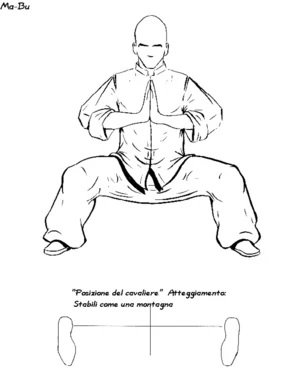
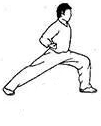
弓步 gong bu (bow stance) is the long stride in which the leading foot points
straight ahead and the back foot is at a 45-degree angle. How long, low, and wide the stride
varies with the individual and the style of tai chi. In the modern forms long and low is good,
as long as you don’t have to lunge or lurch to move around, and about 8 inches in width is
desirable. The weight is 60-70% on the leading foot.
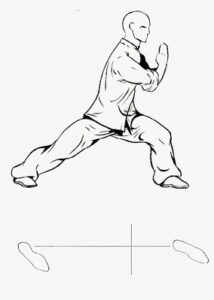

虚步 xu bu (empty stance), the weight is entirely (or at least 90%) on one foot. The other can be in front with the ball of the foot or the heel touching and bearing a slight amount of weight. A variation is 点步, dian bu, in which the foot is pointed.
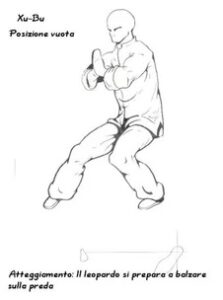

仆步 pu bu is a low stance in which the body is turned sideways and one
leg is folded into a low squat while the other is extended. This stance is
also called fu hu (tame the tiger), and is most famously exemplified in the
taiji movement called Snake Creeps Down. Both feet face front, parallel,
and the heel of the bent leg should be on the ground. The weight is 60-
70% on the sitting foot. The upper body should be upright.


歇步 xie bu (resting stance) is a low position with the legs folded. The front foot points straight ahead and bears most of the weight. The knee of the back foot is turned in and rests on the back of the front leg. The heel of the back foot is off the ground.
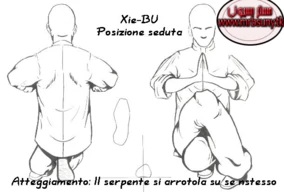
Tai Chi 24 Yang style short form
Footwork
Footwork back view
Footwork front view
Handwork front view
Handwork back view
combing horse mane side view
combing horse mane back view
crane back view
crane side view
You can download the below form to track your progress:
24 Yang form reference chart
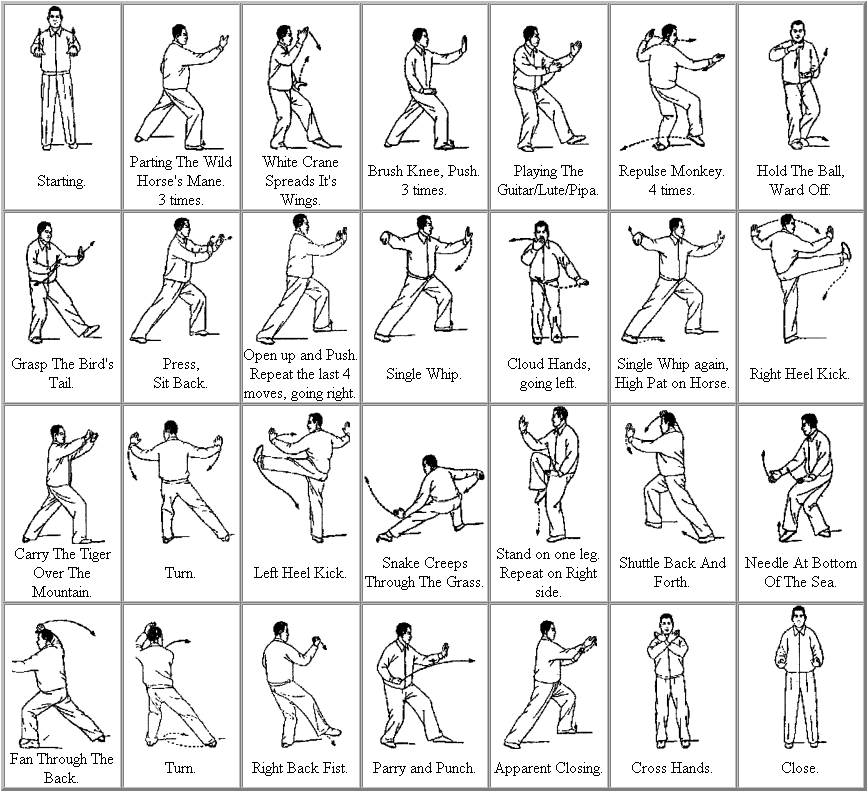
The names of the 24 Yang style form.
1. Beginning
2. Parting the Wild Horse’s Mane (3 times)
3. White Crane Spreads its Wings
4. Brush Knee and Side Step (3 times)
5. Play the Lute
6. Step Back and Repulse Monkey (4 times)
7. Grasp the Sparrow’s Tail – left
8. Grasp the Sparrow’s Tail – right
9. Single Whip
10. Wave Hands Like Clouds (3 times)
11. Single Whip
12. High Pat on Horse
13. Kick with Right Heel
14. Strike (both) Ears with Fists
15. Kick with Left Heel
16. Snake Creeps Down (left) & Golden Cockerel (rooster) Stands on left leg
17. Snake Creeps Down (right) & Golden Cockerel (rooster) on right leg
18. Fair Lady Weaves the Shuttle (right and left)
19. Needle at the Bottom of the Sea
20. Fan through Back
21. Deflect Downwards, Parry and Punch (aka reverse punch)
22. Apparent Close Up
23. Cross Hands
24. Closing Form
24 Yang form demo
